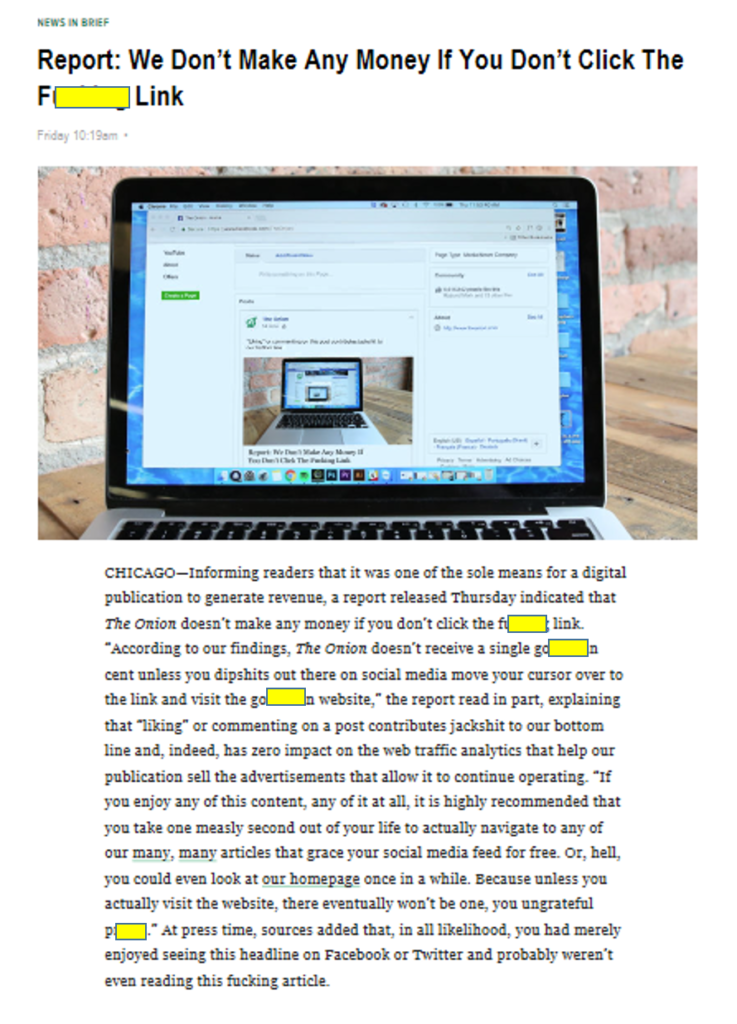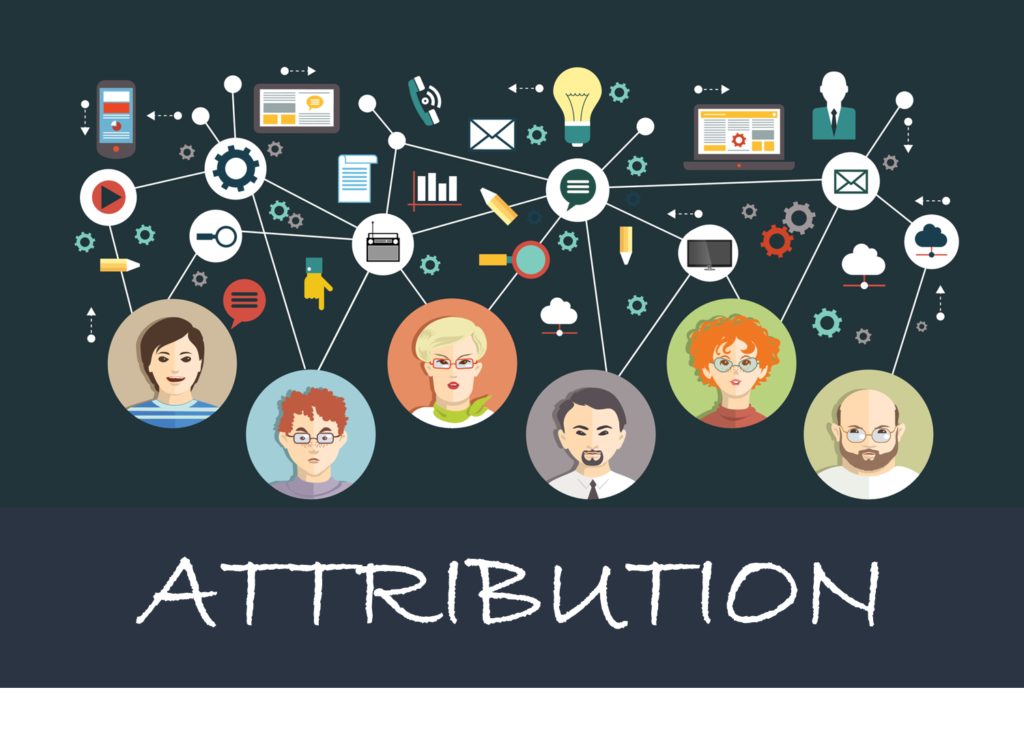
We know the media business is at “a moment in time.” There’s change in the air, and for radio, it’s not just about the shifts that are taking place in station ownership, bankruptcies, and consolidation.
As spot revenue continues to flatten out and all attention turns to the digital ecosphere, broadcasters often struggle to get their arms around a new yardstick; a new set of metrics that threaten to destablize the industry’s financial model. But this same revolution measurement offers legacy media a chance to tell a richer, more robust story – if they can figure out how to tell it.
Our company has been involved in research during the past two years among advertisers. More often than not, they still appreciate traditional media but they desire a mix with digital. Problem is, they don’t always know precisely what “digital” is, how to buy it, analyze it, and apply it to their marketing efforts.
I thought of that the other day when one of those whacked-out “news stories” from the Onion showed up in my Twitter feed. Premised as the rationale for why it’s important to web publishers that users not just “like” their stories in social media, but actually click on links, the memo is loaded with trademark Onion snark. It was quite NSFW so with a little help from the Congressional redaction department, it appears below:

You can read it in its uncensored glory here.
The underlying message of this bit of Onion saracasm points to the falacy of digital advertisng. Is it more important to get a “click” than a “like?” If advertisers are honest with themselves, it’s about results: store traffic, butts in seats, and purchase behavior.
A century ago, merchant John Wanamaker uttered this famous phrase that has haunted marketers ever since:
“Half the money I spend on advertising is wasted; the trouble is I don’t know which half.”
Things haven’t changed all that much in the world of marketing – until now. There is a digital transition in motion truly becoming a rallying cry – among both agencies and radio broadcasters. The radio industry knows it must make the case the medium remains a viable, relevant, and effective marketing tool. Even a digital world.
It’s the new “A-word” – attribution.
And you hear it more and more in conversations about the efficacy of radio advertising in a world of adwords and search. Late last year, I was on a “connected car” panel in Los Angeles featuring two very wise digital mavens from radio’s two biggest companies – Entercom and iHeartMedia. Tim Murphy and Federico Garza were clear about how their respective organizations are actively working hard to identify tools that make a positive connection between radio advertising and consumer response – namely, sales.
In fact, we joked at the time that if the word “attribution” was a keyword in a drinking game, the entire room would have been hammered because the term was uttered again and again, particuarly in conjuntion with the future of the automotive industry. The vehicles that move us from Point A to Point B are rapidly becoming marketing engines that will help reinforce the link between marketing and action.
And it reminded me of our DASH conference back in November 2014. One of our special guests was Dave DiMeo, then head of Ford Direct, the marketing arm of the automaker that deploys co-op dollars to their thousands of car dealers around the country. The clip below was an epiphany to me at the time – as it was for most of the radio professionals in that Metro Detroit conference ballroom:
DiMeo’s big conclusion?
“I don’t want to pay for ears. I want to pay for actions.”
That’s the essence of radio’s dilemma – but it’s also an attribution opportunity. Yet, in order to make it a reality, the industry will not only have to develop credible tools that make these connections, it will have to wean radio reps off their default sales pitches: rankers and reach.
For advertisers, it is less and less about the dimensions of an audience, the number of “likes” or “retweets,” or the size of an email database.
It’s about results.
Radio is so locked into chasing diaries and meters or setting reach and frequency goals that the true goal of marketing has gotten lost in translation. A 40,000 person database is less important than indentifying and connecting with the 250 people in the metro who are in the market to buy a new car in 2018.

You’re going to hear the A-word – attribution – more and more in the coming months, quarters, and years. From the buyers and planners in big agencies to the owners of local nail salons and pizza joints, decision-makers will be increasingly loath to spending marketing dollars that reach undifferentiated listeners who may – or may not – make a purchase, walk into a showroom, or attend an event.
Right now, there are smart poeple working on attribution models for radio – tools that will help the industry connect the dots and provide proof positive that shows radio truly motivates action. Some products coming to market show a great deal of promise for making radio’s attirbution case.
Ad dollars, in fact, are moving to digital – especially social media and search. But credible data that help broadcasters prove theier point that traditional media – especially when melded with strong digital support – may be the most powerful tool of all.
Radio advertising can make a comeback, re-establishing its position as a reach medium that works. Even John Wanamaker would be impressed with where we’re headed.
It’s all about attribution.
- Like A Pair Of Old Jeans - April 2, 2025
- What’s Fair Is Fair - April 1, 2025
- What’s On Your Bucket List? - March 31, 2025




Great summary of the issue facing all broadcasters these days. Attribution is indeed the “holy grail” for many who are looking for ways to improve advertising options for their clients. As a provider of attribution tools, we (LeadsRx.com) have worked with several broadcasters to better understand the true impact of radio advertising and have found some very interesting insights for clients. It’s only a matter of time before this type of analysis will be commonplace for all advertisers… who will also want ways to compare radio to digital media as well.
Agree with all this, A.J. We’re all slogging our way through new metrics and new analytical tools. It is so essential that radio advance the ball down the field. Thanks for commenting.
With attribution, there exists practical, precedented proof that our beloved radio industry can grow by billions; despite our industry’s seeming determination – despite years of falling/flat-lining revenue – to continue its course, without collective, corrective action.
This is an opportunity for the radio revenue model to hit the reset button – and ratchet radio’s flat-lining revenue trajectory upward.
How? By giving advertisers what they tell us (what Gord Borrell’s studies repeatedly prove) – what advertisers want, but our industry is collectively refusing to deliver.
What do advertisers want? In markets small and large, for advertisers local and national, give them 52 weeks of documented sales results –
directly attributed to their media buy on each of our stations, driven by
– over-arching *marketing* strategies focused on the client’s needs and opportunities – NOT *station-focused* presentations
– delineating the systems, strategies, tactics and tools to monetize advertiser needs and opportunities
– going far beyond our industry’s typical presentations too often focused on one or more of rankers, reach reports, three spec spots and a schedule, another “me too” digital offering (not much unlike hundreds of other digital providers located within each station’s signal), plus a promotion thrown in for “added value”.
All stations have the ability to further capitalize on radio’s advantage in catalyzing pre-need, pre-search, pre-purchase consumer consciousness. Capture and track “Now” and “Future” buyer information for advertisers along the way, and deliver them the dollars that come from your services in marketing to their consumers through their buyer journey: on-air, online, off-air.
There are those inside and outside our industry who have profitably executed attribution with documented sales results, that justify advertisers spending more with them, rather than the competition. These approaches generate more revenue per hour of prospecting, preparation, presenting, closing and servicing than what radio does today.
Why? Irrefutable evidence: the advertisers can count the dollars and cents generated from the marketing strategies driving the campaigns with each media company.
If one person can generate millions doing so, our industry can generate billions.
What could happen, if those that have walked the talk, would pay it forward and freely share how others can do so for themselves?
Mr. Jacobs, sir, your website would provide an excellent forum.
Can we make this easy? I worked for stations that would embark on major promotions intended to increase audience. The smart sales managers would get their best clients on the air during this time of “maximum tune-in”…and everyone would win. The answer here lies in getting radio to do what we’re asking retailers, car dealers, furniture stores, insurance companies, banks (etc.) to do. A D V E R T I S E. There are dozens (if not hundreds) of people in our industry who know how to win (Fred included) but it seems their hands are tied at every turn these days. Right now the “fish” are still swimming around broadcast more than digital. Sooner or later someone’s gonna look at one of these “smart” people and say -“You do it your way” – and watch what happens. It happened with Todd Storz, Bill Drake, Buzz Bennett, Jerry Clifton – it will happen again . . radio has to remain top of mind so the listener can be excited about what they’re hearing!!
Dave, we may be reaching that point in time. Ideas have always been the currency. Appreciate the comment and you reading our blog.
Advertisers ARE beginning to notice and they now have the tools to measure which half of their dollars are vs are not working. Witness P&G, which just reallocated $200 million annually from its digital advertising budget to electronic media. P&G made this move after determining that the average pair of eyeballs was viewing their message for 1.7 seconds and that they weren’t getting a good return on their investment.
Packaged goods avoided radio because it wasn’t electronically measured. Packaged goods were supposed to be the Holy Grail of the “Meter.” Radio needs to help advertisers understand what P&G spent so much to learn – AND – for P&G to recognize that we now are electronically measured as they demanded.
Thar’s gold in them thar hills!
Andy, as you suggest, it’s a whole new day. Many big brands are having second thoughts about the effectiveness of digital – including the issue of no control over other ads and post that may show up in close proximity. And I agree with your comments about the need to educate advertisers about radio’s growing accountability. Thanks for commenting.